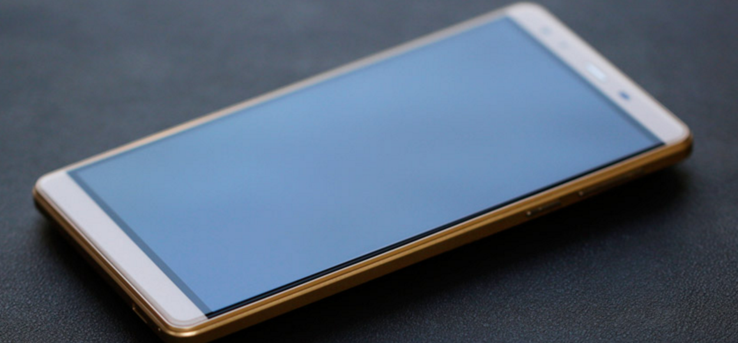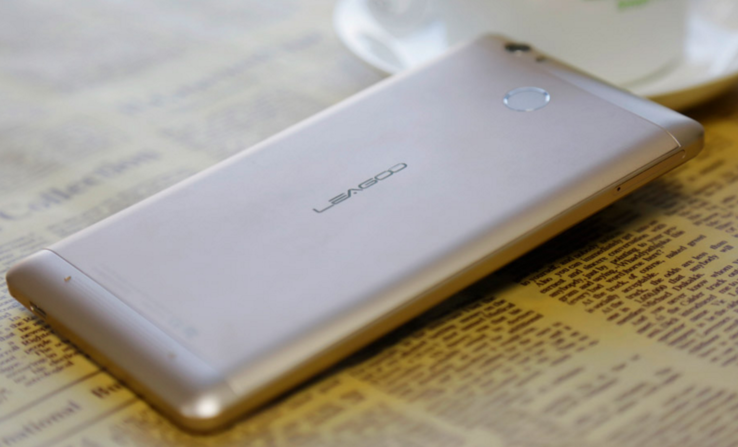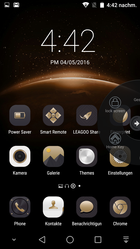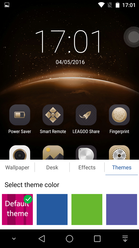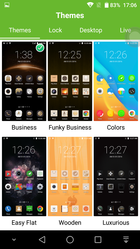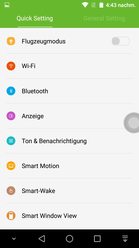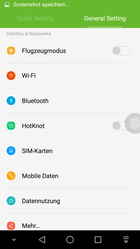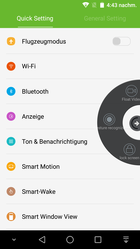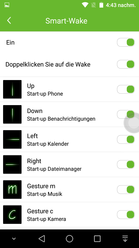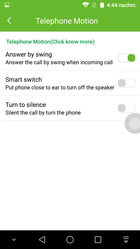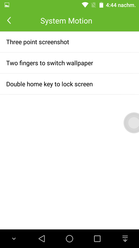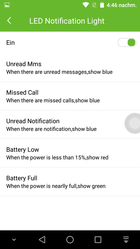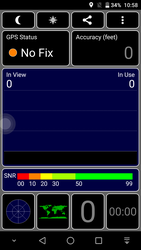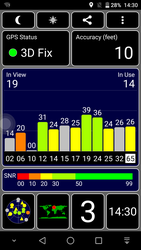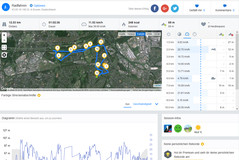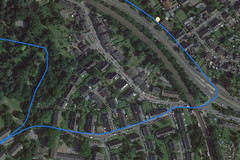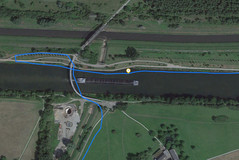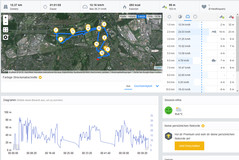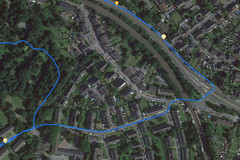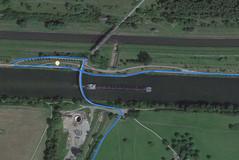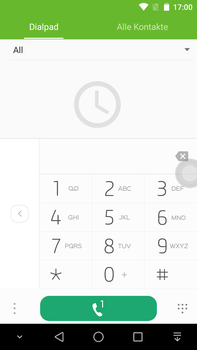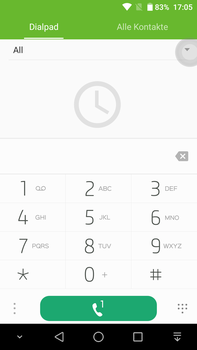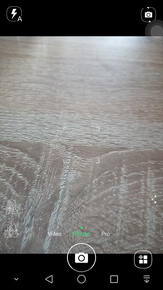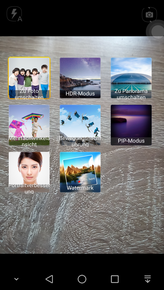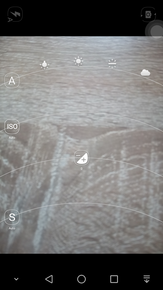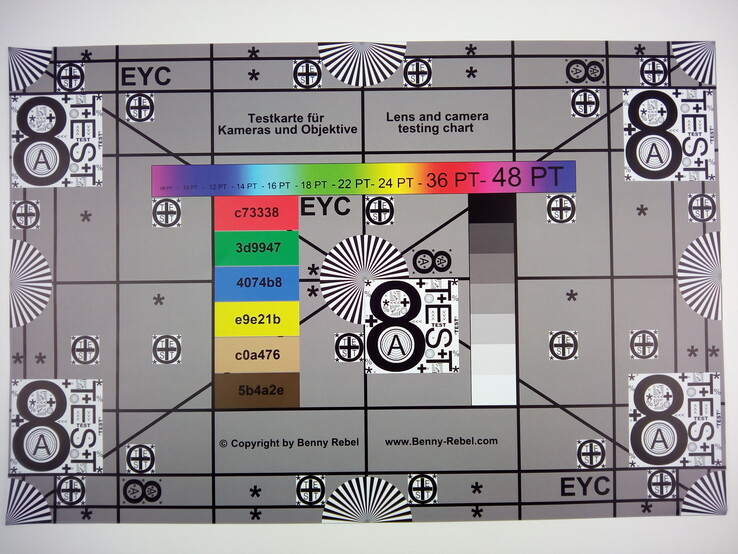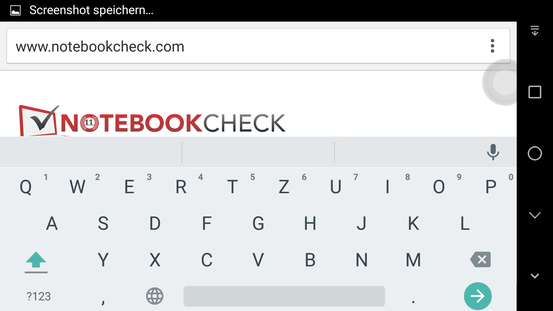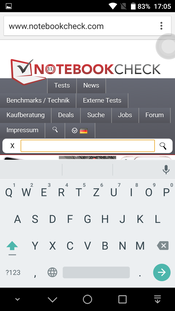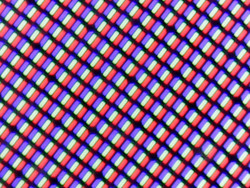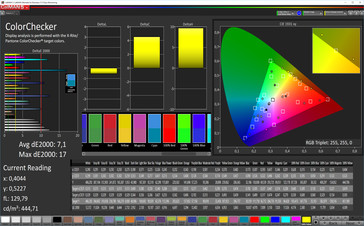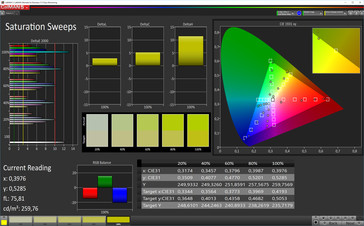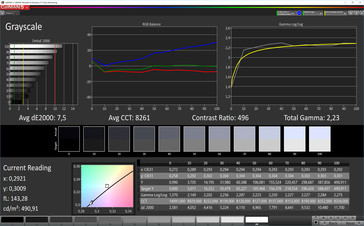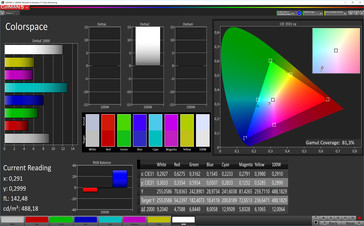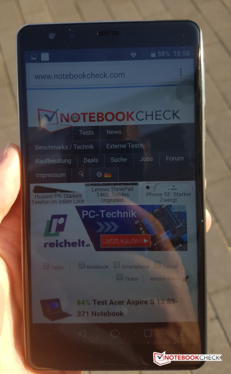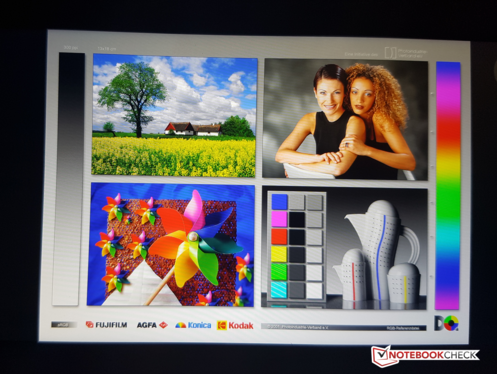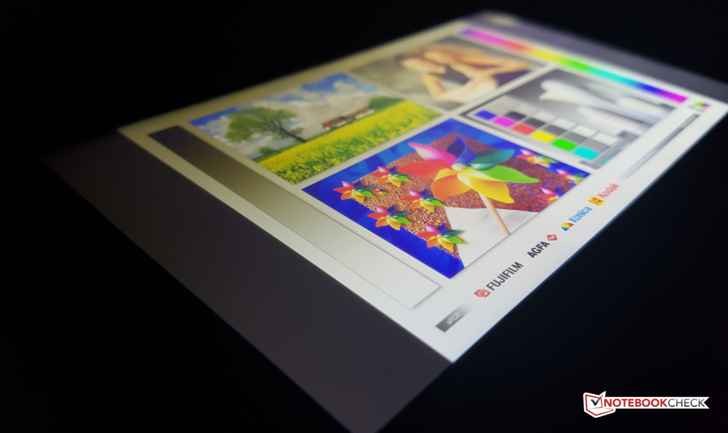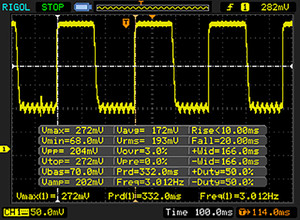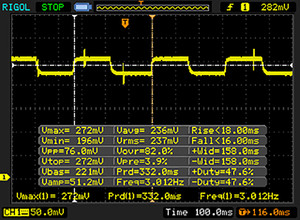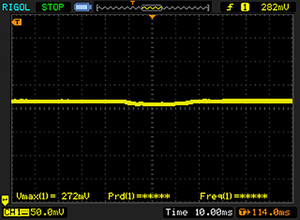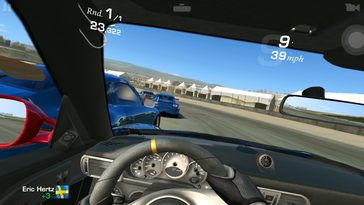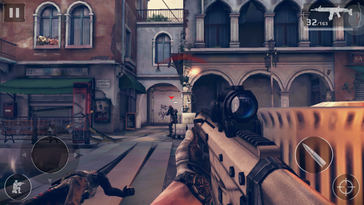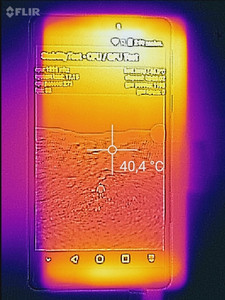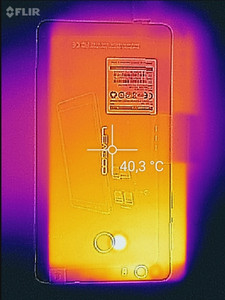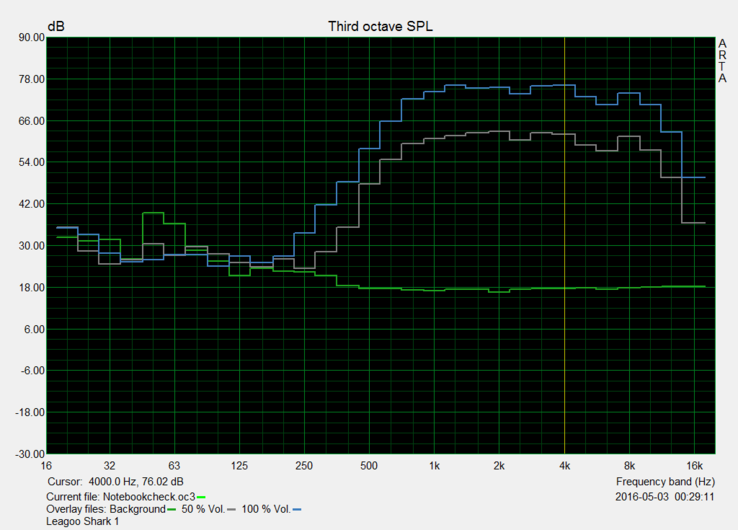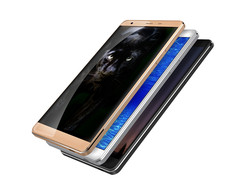Leagoo Shark 1 Smartphone Review

For the original German review, see here.
Leagoo's 6-inch phablet comes extremely well-equipped for a lower middle-class smartphone: Mediatek octa-core SoC, 3 GB RAM, LTPS display with a resolution of 1920x1080 pixels, 6300 mAh battery with quick-charge technology, dual-SIM functionality, and a fingerprint sensor - the specs are impressive indeed. The smartphone comes with 16 GB of flash storage, which of course can be expanded.
The LTE smartphone can be purchased for 170 Euros (~$190) from various importers in black, gold, or silver. Leagoo does not have an official distribution channel in Germany. Competitors are other Android smartphones like the Allview P8 Energy, Oukitel K4000 Pro and the Elephone P8000. The Lumia 640 XL from Microsoft with Windows 10 Mobile is also phablet-sized with a comparable battery capacity and could be considered a contender as well.
Case
Visually, the Shark 1 makes a very good first impression with a design reminiscent of the Huawei Mate 8. The front, which is protected with Gorilla Glass 3, is characterized by an extremely narrow bezel separating the IPS panel itself and the plastic frame. About 75.6% of the rounded 2.5D-front is covered by the display - an excellent ratio. That in turn means that the Shark 1 is only marginally larger than the Lumia 640 XL, which features a display measuring 0.3 inches less. Because of the size, the weight of 241 grams isn't quite as noticeable as in other cases - take the Oukitel K4000 Pro for example. Since the smartphone is only 8.5 mm thick, it's still quite manageable despite measuring 158.6 x 82.8 mm.
The rounded back is mostly made of metal, although there are plastic elements on the top and the bottom, which likely cover the antennas. The color of these plastic elements unfortunately looks a little washed out so the pieces don't quite match visually. The transition between the two case materials also leaves something to be desired, as the gaps are uneven and wavy. Otherwise the build quality is pretty decent.
The volume keys and the on/off switch feel a bit too spongy when pressed. The case itself is quite solid, although the back yields when pressure is applied.
Connectivity
For a middle-class smartphone, the Shark 1 doesn't leave much to be desired. In addition to an infrared sensor at the top, the smartphone also houses a fingerprint sensor, a notification LED, an FM radio, as well as 16 GB of expandable flash storage. A2SD functionality allows the user to relocate applications to a microSDXC card. USB flash drives can be connected to the USB 2.0 port using an OTG (On-the-Go) adapter.
Wireless content can be transferred to external monitors using Miracast. We had no issue when we put the technology to use and connected to a Sony Android TV.
Software
The OS of choice is Google's one-year-old Android 5.1 Lollipop, which, at the time of our review, had a security patch from March 2016 installed. Leagoo has not announced yet if an update to the newest Android 6.0 Marshmallow is planned for the future or not.
Leagoo updated the stock Android version with their own user interface called "Leagoo OS" (version 1.2). Installed apps are not collected in an app drawer but are placed on the home-screen instead. The user can modify and update the design by connecting to the Leagoo theme store. The notification area and the settings menu also look very different from the base Android version.
In addition to the visual changes and differences, Leagoo also adds a lot of software to the heavily modified OS. With predefined inputs it's possible to start applications with the phone in standby. Drawing the letter "c" on the turned-off display, for example, starts the camera app.
Leagoo's implementation of the system language is inconsistent: when we picked German, most of the text was indeed in that language, but quite a few entries remained in English.
Communication & GPS
The integrated WLAN module supports IEEE 802.11 standards a/b/g/n. The reception quality is good and the signal remains stable at all times. Bluetooth 4.0 is on board as well. The phone lacks NFC, but Mediatek's HotKnot-technology has similar functionality: when two phones supporting HotKnot touch each other, data can be transferred between them.
The dual-SIM smartphone connects to mobile networks via two microSIM-cards. Both slots support dual-band GSM, dual-band UMTS, as well as LTE at 800, 1800, 2100, and 2600 MHz (which means that LTE band 20 is supported as well, which is important in Germany's more rural areas). The connection quality was about average and the reception in our large city acceptable.
The GPS module supports all main satellite systems, namely GPS, GLONASS and BeiDou. Despite that fact, it took a while to establish our position outside and the recorded accuracy was about 3 meters / 10 feet. Indoors, the Shark 1 was unable to locate any satellites.
Compared to the professional Garmin Edge 500, the GPS module in the Leagoo Shark1 proved to be somewhat imprecise, as the measured distance after our 12.6 km / 7.83 mile test section was off by about 350 meters / 0.22 miles. Considering that all major satellite systems are supported, the result was not as accurate as expected, although the overall GPS quality is still sufficient.
Telephone & Voice Quality
Test calls with the review smartphone in our mobile network ("E" network) went without a hitch. The sound quality was good and we didn't encounter any noise artifacts during our conversations. The maximum volume makes hearing the call partner quite easy. Since the microphone doesn't offer noise suppression, louder environments can be problematic, however. The quality of the built-in microphone isn't great: our call partner attested low volume and told us that we weren't exactly easy to understand.
Cameras
The rear-facing camera features a Sony (Exmor IMX 214 RS) CMOS sensor with a resolution of 13.3 MP and an aperture of f/2.8. Photos look good on the 6-inch display - at least as long as there was sufficient light when the picture was taken. In lower ambient light conditions, the older Sony sensor produces a lot of noise (see scene 3). The dual-LED flash unfortunately doesn't improve the result much. Checking the quality while zoomed in though reveals an even greater problem: certain areas suffer from partial blurring, which lessens the picture quality significantly. Maybe software optimization could improve the results. The dynamic range is limited as well (photos scene 1 & scene 2); in addition, the sharpness is reduced significantly towards the edges (see the test chart). The color accuracy is quite good, however.
The front-facing camera only has a resolution of 5.3 MP. Selfies don't look too good, since the focus is off and the resulting photos aren't very sharp. The phone records videos at up to 720p at 30 fps. The rear-facing camera allows for 1080p at 30 fps.
Accessories & Warranty
The box contains the smartphone itself, a user manual, warranty pamphlet, in-ear headphones, a USB cable, and the modular power adapter. The Shark 1 is warranted against defects for a period of 12 months.
Input Devices & Operation
The capacitive multi-touch works flawlessly and inputs are translated without any delay. The smartphone is controlled via buttons on the display. The Shark 1 comes with the standard Android Google keyboard - Leagoo, doesn't provide a customized version.
The active fingerprint scanner mostly works as advertised, although it's not the fastest of its kind. Trying to unlock the Shark 1 often required a second attempt. Up to five fingerprints can be registered and the system recognized them after a short delay. Smartphones like the Galaxy S7 edge or the Huawei Mate 8 are much faster here.
Display
Leagoo uses a 6-inch LTPS (Low Temperature PolySilicon) active matrix display from LG Electronics. The IPS panel supports a resolution of 1920x1080 pixels and features a corresponding pixel density of 367 ppi. The display content is thus very sharp.
At up to 507 cd/m², the display of the Shark 1 gets very bright, although the average brightness is much lower at about 465 cd/m², since the brightness distribution is only 82%. When we checked the display brightness with evenly distributed dark and bright areas (APL 50), we recorded a maximum of 482 cd/m² (black value 0.9 cd/m²).
| |||||||||||||||||||||||||
Brightness Distribution: 82 %
Center on Battery: 471 cd/m²
Contrast: 523:1 (Black: 0.9 cd/m²)
ΔE ColorChecker Calman: 7.1 | ∀{0.5-29.43 Ø4.8}
ΔE Greyscale Calman: 7.5 | ∀{0.09-98 Ø5.1}
Gamma: 2.23
CCT: 8261 K
| Leagoo Shark 1 Mali-T720 MP2, MT6753, 16 GB eMMC Flash | Allview P8 Energy Mali-T720 MP2, MT6735, 16 GB eMMC Flash | Elephone P8000 Mali-T720 MP4, MT6753, 16 GB eMMC Flash | Oukitel K4000 Pro , MT6735, 16 GB eMMC Flash | Microsoft Lumia 640 XL Adreno 305, 400 MSM8226, 8 GB eMMC Flash | Huawei Mate 8 Mali-T880 MP4, Kirin 950, 32 GB eMMC Flash | |
|---|---|---|---|---|---|---|
| Screen | -12% | 4% | 12% | 40% | 48% | |
| Brightness middle (cd/m²) | 471 | 299 -37% | 338 -28% | 360 -24% | 501 6% | 514 9% |
| Brightness (cd/m²) | 465 | 302 -35% | 329 -29% | 367 -21% | 492 6% | 513 10% |
| Brightness Distribution (%) | 82 | 94 15% | 95 16% | 89 9% | 86 5% | 94 15% |
| Black Level * (cd/m²) | 0.9 | 0.36 60% | 0.36 60% | 0.44 51% | 0.35 61% | |
| Contrast (:1) | 523 | 939 80% | 1000 91% | 1139 118% | 1469 181% | |
| Colorchecker dE 2000 * | 7.1 | 8.27 -16% | 9.38 -32% | 9.01 -27% | 3.89 45% | 5.08 28% |
| Colorchecker dE 2000 max. * | 17 | 12.58 26% | 8.28 51% | |||
| Greyscale dE 2000 * | 7.5 | 6.43 14% | 10.33 -38% | 8.67 -16% | 3.97 47% | 5.49 27% |
| Gamma | 2.23 99% | 2.3 96% | 2.3 96% | 2.66 83% | 2.34 94% | 2.08 106% |
| CCT | 8261 79% | 7182 91% | 10118 64% | 7641 85% | 6657 98% | 7254 90% |
| Color Space (Percent of AdobeRGB 1998) (%) | 79.95 | |||||
| Color Space (Percent of sRGB) (%) | 99.84 |
* ... smaller is better
For an IPS display, the Shark 1's black value of 0.9 cd/m² is subpar. The corresponding contrast ratio is only 523:1. The middle-class smartphone also has some issues with the color accuracy and some of the measured deviations are very high. The lighter gray levels show a distinctly bluish hue, which means that the screen content appears quite cool. The coverage of the color spaces is also not that great according to our CalMAN measurements.
The liquid-crystal display does very well outside and the screen content is readable even in brighter environments. The viewing-angle stability of the LTPS display is also top notch and the picture darkens only marginally at very shallow angles. The colors do invert ever so slightly, however.
Display Response Times
| ↔ Response Time Black to White | ||
|---|---|---|
| 30 ms ... rise ↗ and fall ↘ combined | ↗ 10 ms rise | |
| ↘ 20 ms fall | ||
| The screen shows slow response rates in our tests and will be unsatisfactory for gamers. In comparison, all tested devices range from 0.1 (minimum) to 240 (maximum) ms. » 79 % of all devices are better. This means that the measured response time is worse than the average of all tested devices (20.4 ms). | ||
| ↔ Response Time 50% Grey to 80% Grey | ||
| 34 ms ... rise ↗ and fall ↘ combined | ↗ 18 ms rise | |
| ↘ 16 ms fall | ||
| The screen shows slow response rates in our tests and will be unsatisfactory for gamers. In comparison, all tested devices range from 0.165 (minimum) to 636 (maximum) ms. » 45 % of all devices are better. This means that the measured response time is similar to the average of all tested devices (31.8 ms). | ||
Screen Flickering / PWM (Pulse-Width Modulation)
| Screen flickering / PWM not detected | |||
In comparison: 53 % of all tested devices do not use PWM to dim the display. If PWM was detected, an average of 8214 (minimum: 5 - maximum: 343500) Hz was measured. | |||
Performance
The Shark 1 is equipped with an octa-core SoC, the Mediatek MT6753. This middle-class processor is manufactured using a 28 nm process and is based on the 64-bit capable Cortex A53 architecture. Also on board are an ARM Mali-T720 MP2 and 3GB DDR2 RAM. At the time of our review, the 64-bit processor architecture wasn't supported, since Android 5.1 only supports 32-bit operation.
Both the subjective performance and the benchmarks results are quite impressive. Aside from a few exceptions the system ran smoothly. The browser performance is also decent: content loads quickly and scrolling works fine, even though not without some minor stutters.
The internal flash drive is very fast - according to AndroBench 3, the 4 KB sequential random read rates even surpass those of our reference smartphone Huawei Mate 8.
| AnTuTu v6 - Total Score (sort by value) | |
| Leagoo Shark 1 | |
| Oukitel K4000 Pro | |
| Huawei Mate 8 | |
| Geekbench 3 | |
| 64 Bit Single-Core Score (sort by value) | |
| Allview P8 Energy | |
| Elephone P8000 | |
| Huawei Mate 8 | |
| 64 Bit Multi-Core Score (sort by value) | |
| Allview P8 Energy | |
| Elephone P8000 | |
| Huawei Mate 8 | |
| 32 Bit Multi-Core Score (sort by value) | |
| Leagoo Shark 1 | |
| Oukitel K4000 Pro | |
| 32 Bit Single-Core Score (sort by value) | |
| Leagoo Shark 1 | |
| Oukitel K4000 Pro | |
| 3DMark | |
| 1280x720 offscreen Ice Storm Unlimited Score (sort by value) | |
| Leagoo Shark 1 | |
| Allview P8 Energy | |
| Elephone P8000 | |
| Oukitel K4000 Pro | |
| Huawei Mate 8 | |
| 1280x720 offscreen Ice Storm Unlimited Graphics Score (sort by value) | |
| Leagoo Shark 1 | |
| Allview P8 Energy | |
| Elephone P8000 | |
| Oukitel K4000 Pro | |
| Huawei Mate 8 | |
| 1280x720 offscreen Ice Storm Unlimited Physics (sort by value) | |
| Leagoo Shark 1 | |
| Allview P8 Energy | |
| Elephone P8000 | |
| Oukitel K4000 Pro | |
| Huawei Mate 8 | |
| 2560x1440 Sling Shot OpenGL ES 3.0 (sort by value) | |
| Leagoo Shark 1 | |
| Allview P8 Energy | |
| Elephone P8000 | |
| Oukitel K4000 Pro | |
| Huawei Mate 8 | |
| 2560x1440 Sling Shot OpenGL ES 3.0 Graphics (sort by value) | |
| Leagoo Shark 1 | |
| Allview P8 Energy | |
| Elephone P8000 | |
| Oukitel K4000 Pro | |
| Huawei Mate 8 | |
| 2560x1440 Sling Shot OpenGL ES 3.0 Physics (sort by value) | |
| Leagoo Shark 1 | |
| Allview P8 Energy | |
| Elephone P8000 | |
| Oukitel K4000 Pro | |
| Huawei Mate 8 | |
| GFXBench (DX / GLBenchmark) 2.7 | |
| T-Rex Onscreen (sort by value) | |
| Leagoo Shark 1 | |
| Allview P8 Energy | |
| Elephone P8000 | |
| Oukitel K4000 Pro | |
| Microsoft Lumia 640 XL | |
| Huawei Mate 8 | |
| 1920x1080 T-Rex Offscreen (sort by value) | |
| Leagoo Shark 1 | |
| Allview P8 Energy | |
| Elephone P8000 | |
| Microsoft Lumia 640 XL | |
| Huawei Mate 8 | |
| GFXBench 3.0 | |
| on screen Manhattan Onscreen OGL (sort by value) | |
| Leagoo Shark 1 | |
| Allview P8 Energy | |
| Elephone P8000 | |
| Oukitel K4000 Pro | |
| Huawei Mate 8 | |
| 1920x1080 1080p Manhattan Offscreen (sort by value) | |
| Leagoo Shark 1 | |
| Allview P8 Energy | |
| Elephone P8000 | |
| Oukitel K4000 Pro | |
| Huawei Mate 8 | |
| GFXBench 3.1 | |
| on screen Manhattan ES 3.1 Onscreen (sort by value) | |
| Leagoo Shark 1 | |
| Oukitel K4000 Pro | |
| Huawei Mate 8 | |
| 1920x1080 Manhattan ES 3.1 Offscreen (sort by value) | |
| Leagoo Shark 1 | |
| Oukitel K4000 Pro | |
| Huawei Mate 8 | |
| PCMark for Android - Work performance score (sort by value) | |
| Leagoo Shark 1 | |
| Oukitel K4000 Pro | |
| Huawei Mate 8 | |
| Mozilla Kraken 1.1 - Total (sort by value) | |
| Leagoo Shark 1 | |
| Allview P8 Energy | |
| Elephone P8000 | |
| Oukitel K4000 Pro | |
| Microsoft Lumia 640 XL | |
| Huawei Mate 8 | |
| Octane V2 - Total Score (sort by value) | |
| Leagoo Shark 1 | |
| Allview P8 Energy | |
| Elephone P8000 | |
| Oukitel K4000 Pro | |
| Microsoft Lumia 640 XL | |
| Huawei Mate 8 | |
| JetStream 1.1 - Total Score (sort by value) | |
| Leagoo Shark 1 | |
| Allview P8 Energy | |
| Elephone P8000 | |
| Oukitel K4000 Pro | |
| Huawei Mate 8 | |
| AndroBench 3-5 | |
| Random Write 4KB (sort by value) | |
| Leagoo Shark 1 | |
| Allview P8 Energy | |
| Elephone P8000 | |
| Oukitel K4000 Pro | |
| Huawei Mate 8 | |
| Random Read 4KB (sort by value) | |
| Leagoo Shark 1 | |
| Allview P8 Energy | |
| Elephone P8000 | |
| Oukitel K4000 Pro | |
| Huawei Mate 8 | |
| Sequential Write 256KB (sort by value) | |
| Leagoo Shark 1 | |
| Allview P8 Energy | |
| Elephone P8000 | |
| Oukitel K4000 Pro | |
| Huawei Mate 8 | |
| Sequential Read 256KB (sort by value) | |
| Leagoo Shark 1 | |
| Allview P8 Energy | |
| Elephone P8000 | |
| Oukitel K4000 Pro | |
| Huawei Mate 8 | |
* ... smaller is better
Gaming
The integrated entry-level graphics processor Mali-T720 MP2 handles even more demanding 3D games fluently most of the time. Current Android games like Real Racing 3 or Modern Combat 5 ran without any problems whatsoever.
Emissions
Temperature
Even during idle, the Leagoo Shark 1 gets quite warm - we measured 39.3 °C on the front. Under load, the smartphone gets hotter still at a maximum of 45 °C – too high in our opinion. Especially while gaming, the case gets uncomfortably hot in some areas.
(±) The maximum temperature on the upper side is 45 °C / 113 F, compared to the average of 35.2 °C / 95 F, ranging from 21.9 to 247 °C for the class Smartphone.
(±) The bottom heats up to a maximum of 42.3 °C / 108 F, compared to the average of 33.9 °C / 93 F
(±) In idle usage, the average temperature for the upper side is 36.6 °C / 98 F, compared to the device average of 32.9 °C / 91 F.
Speaker
Energy Management
Power Consumption
The smartphone isn't particularly frugal. Under load, we measured up to 7.50 watts, which means that the Shark 1 draws more power than comparable smartphones and even surpasses the 9.7-inch tablet from Haier we reviewed recently. Even while idling, the Shark 1 requires 3.5 watts, which is above average.
| Off / Standby | |
| Idle | |
| Load |
|
Key:
min: | |
Battery Life
The battery capacity is quite large for a smartphone with 6300 mAh. Even when the capacity is substantial, the power consumption has to be reasonable to ensure long runtimes. The Shark 1 did reasonably well when we conducted our WLAN test with the display brightness set to 150 cd/m² - but considering the capacity, 9 hours and 2 minutes is still disappointing. The Huawei Mate 8 has the same display size and features a battery with two-thirds of the capacity - but still lasted 60 % longer in our test. This clearly shows the effect of the high power consumption.
Thanks to Leagoo's own quick-charge technology - called LGQC V3.0 - the Shark 1 charges in 2 hours and 10 minutes despite the high battery capacity.
| Leagoo Shark 1 Mali-T720 MP2, MT6753, 16 GB eMMC Flash | Allview P8 Energy Mali-T720 MP2, MT6735, 16 GB eMMC Flash | Elephone P8000 Mali-T720 MP4, MT6753, 16 GB eMMC Flash | Oukitel K4000 Pro , MT6735, 16 GB eMMC Flash | Microsoft Lumia 640 XL Adreno 305, 400 MSM8226, 8 GB eMMC Flash | Huawei Mate 8 Mali-T880 MP4, Kirin 950, 32 GB eMMC Flash | |
|---|---|---|---|---|---|---|
| Battery runtime | ||||||
| WiFi v1.3 (h) | 9 | 20 122% | 10.6 18% | 11.9 32% | 7.2 -20% | 14.4 60% |
Pros
Cons
Verdict
Leagoo unfortunately wasted a lot of potential with their middle-class smartphone Shark 1. The highlight of the 6-inch phablet is definitely the enormous battery with a capacity of 6300 mAh. According to our measurements, the runtimes are just good and not stellar, however. The subpar energy management rears its ugly head twice, as it not only shortens the battery life but also leads to a smartphone that runs very hot. The display is sourced from a well-known manufacturer and is based on IPS technology, but neither the black value, the contrast nor the color accuracy are particularly impressive. The same is true for the 13 MP main camera with its Sony Exmor sensor, which in theory should allow for decent picture quality - but the camera software needs to be improved in our opinion to deliver on that promise.
What we are left with is - thanks to the narrow bezel - a quite compact 6-inch, decently equipped dual-SIM smartphone with mostly stutter-free performance and sufficient storage space. Many of the aforementioned flaws could likely be remedied with a software update.
The Leagoo Shark 1 likely only appeals to true phablet-enthusiasts who prefer a display size of 6-inches - especially since there aren't that many lower-priced choices in this segment. For all other users, more compact smartphones in the same price range are undoubtedly the better choice, as they simply offer more for the money.
Leagoo Shark 1
- 05/09/2016 v5.1 (old)
Marcus Herbrich




